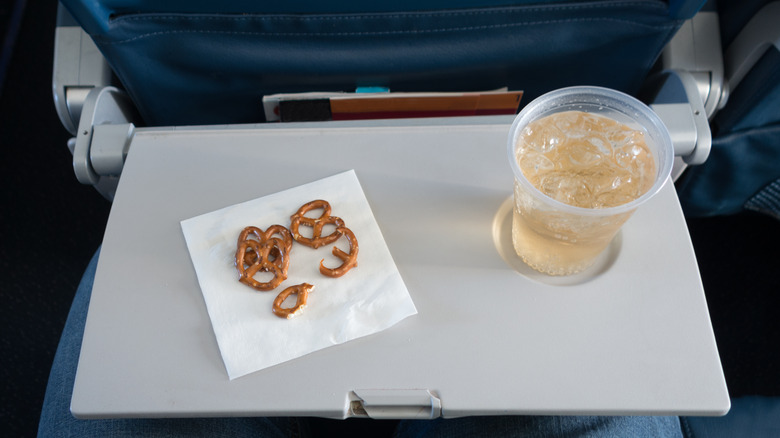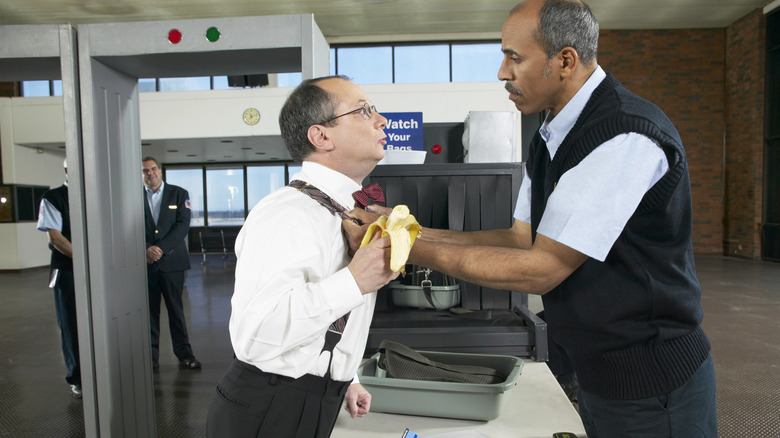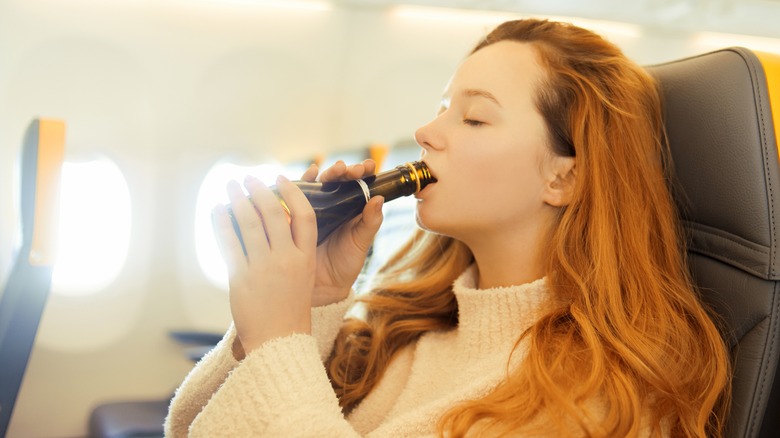The Hard-And-Fast Rule For Bringing Snacks On An Airplane
Unless you're on a long overseas flight, or can afford first-class airfare, you're unlikely to get anything more than a can of soda and a mini-pack of pretzels or cookies when flying. Some airlines may offer the option to buy an extraordinarily-priced snack box, while grab-and-go markets in airport terminals usually offer equally ridiculous markups for snack items. So, what can you do if you know you're going to be hungry after a few hours in the air? Most airlines will allow you to bring your own foods and refreshments on board, although there are a few rules you'll need to follow.
For one, TSA regulations limit the package size of any kind of liquid or even semi-solid food (like yogurt, pudding, or hummus) onboard. Like toiletries, the maximum permitted container size for these kinds of foods is 3.4 ounces. In addition to semi-solid food restrictions, it also means most beverages can't be brought onboard unless you can find teeny-tiny bottles. (However, this baby-sized bottle rule does not apply to actual baby bottles, nor to most other foods intended for infants.)
Apart from the size rule, canned foods may also be subject to scrutiny and an airline may disallow them at their discretion. So it may be best to stick to the traditional chips, jerky, protein bars, and baked goods in your carry-on the next time you fly.
Depending on your destination, you may need to finish your snacks en route
If you're prone to overpacking snacks like you're setting off on an Arctic expedition each time you leave the house, well, you're not alone. (It's a universal "mom" thing, even among those who aren't technically mothers.) This does mean, though, that you may arrive at your destination with your carry-on bag still half full of food. If you're flying domestically in the U.S., this shouldn't be an issue, but if you arrive at an international airport, some of your snacks may not make it through customs.
Without knowing your destination ahead of time (this isn't a psychic hotline, after all), it's impossible to list all the items you can and can't bring into your intended country, so your best bet is to check the territory's customs website before you go. Let this be a heads-up, though – fresh fruits and vegetables are often a no-go, something that also applies if you're flying from Hawaii, Puerto Rico, or the U.S. Virgin Islands to the continental United States.
If your final destination is within the European Union, your produce may be permitted, but you won't be able to take any meat or cheese products through customs. They will allow a limited amount of fish, though, so you probably don't need to finish that tuna sandwich on board. (In fact, your seat partner will thank you if you don't even start it.)
Yes, you can BYOB, but you can't drink it on the plane
If you're wondering whether that on-board liquid rule applies to enjoying your own booze during the flight, the answer is, basically, yes. But, you can bring closed alcohol bottles on board the plane, as long as they're no larger than 3.4 ounces. That's 100 milliliters in metric-speak, and most mini-bottles are 50 milliliters in size. What's more, that 100-milliliter limit is for the container, not the total amount you're allowed. In fact, the TSA will allow you to bring up to a one-quart ziploc bag stuffed with as many minis as you can "comfortably" cram in there.
There are some other caveats as well. The first is that any over-proof spirit of 70% ABV or more isn't permitted either as a carry-on or in your checked luggage, so ditch the grain alcohol before you go. The real restriction, however, is that the booze that you do bring on board must remain unopened throughout the flight.
FAA regulations only permit alcohol consumption if a flight attendant serves it to you, and no, they probably won't be amenable to handing you your own hooch. This checks out once you realize that liquor sales are a huge source of revenue for airlines and they stand to make a lot more selling you on wine, beer, and cocktails than they will on crackers and cheese.


